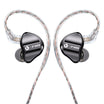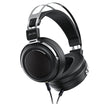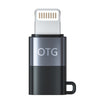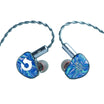Frequency response is the range of bass, mids and treble at which the headphone drivers are capable of reproducing sound from the lowest tones to the highest. Lots of audiophiles ask us if we have headphones with the flattest sound signature. What they're describing is a balanced sound whose frequencies are evenly spread across the entire frequency range.
AUDIBLE FREQUENCIES
The average human ear can hear frequencies between 20 Hertz to 20,000 Hertz. While most basic headphones come with a frequency response of 20Hz-20kHz, there are headphones where the lower frequencies can be as low as 5 Hertz. We've also seen headphones with a higher frequency of 35,000 Hertz. You may think, how can a man possibly hear such a range! Extremely low and high frequencies might not be heard but they're felt, enhancing the ultimate aural headphone experience.
FREQUENCY RESPONSE & MUSIC GENRES
Lower the frequency, more is the thump and bass whereas higher the frequency, you will hear more shrill and sharp sounds. A scientific approach to picking out new headphones should depend on the choice of music genres. For Bollywood, EDM, pop, reggae, techno, and dance hall genres: low frequencies are preferred. Higher frequencies allow one to experience every beat of a classic rock metal song. Someone who enjoys Mozart, Bach or other classical music artists would appreciate the music to be left uncoloured.
LISTEN COMPLETELY
A headphone with a wide frequency response won’t necessarily have great sound, but capable of unveiling musical detail accurately. A song is usually composed using innumerable instruments to fill up the musical paraphernalia. For example, an AR Rahman track would have a tabla to fill up the sub-bass, on the other hand, S. P. Balasubramanyam singing a Raag can bring out the lower mids. Lata Mangeshkar's melodious voice can add a shine to the upper mids, and a clarinet can brighten the treble. Further, with the correct music listening setup, one would hear things that would give you goosebumps. These sounds are spread across the sound spectrum, which you will only hear if your headphone's frequency response allows it and if you have got the right headphones.
FREQUENCY RESPONSE GRAPHS
It's not a very easy task to measure the frequency response of a headphone. This task is accomplished by positioning a sensitive mic to record sound at every single frequency. This mic would be placed right between the headphones in the place ahead. Then you can effectively measure how the headphone reacts to every sound and put it on a graph.






















































Leave a comment
This site is protected by hCaptcha and the hCaptcha Privacy Policy and Terms of Service apply.